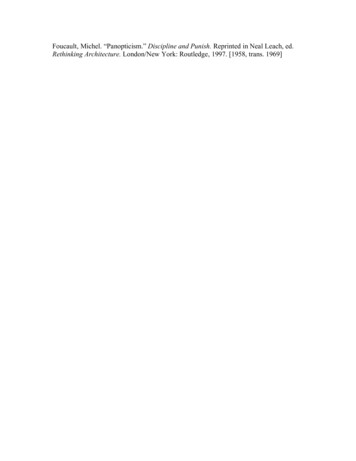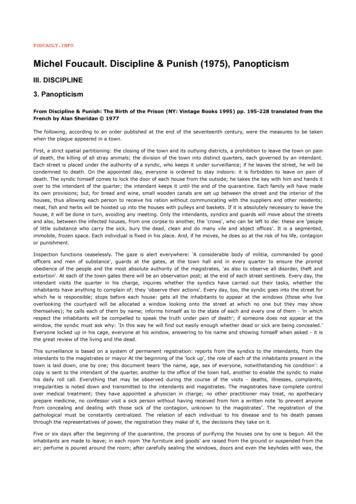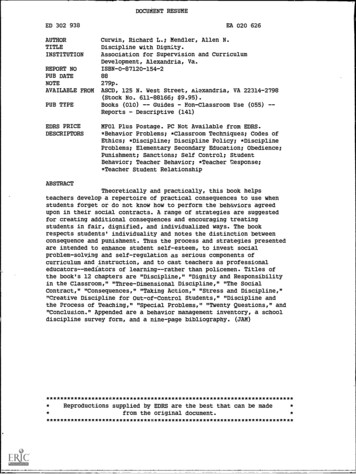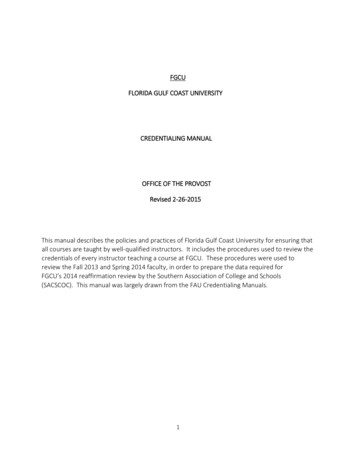
Transcription
Michel FoucaultDISCIPLINE AND PUNISHThe Birth ofthe PrisonITranslated from the FrenchAlan SheridanItII)J1VINTAGE BOOKSA DIVISION OF RANDOM HOUSE, INC . NEW YORK
ContentsList of PlatesTranslator's NotePART ONEviiixTORTUREI.The body of the condemned3.2.The spectacle of the scaffold32.PART TWOPUNISHMENTI.Generalized punishment2.The gentle way in punishmentPART THREEI.73DISCIPLINE135Docile bodiesThe art ofdistrihutionsThe control ofactivity141149The organitation ofgenesesThe composition offorces2.HierarchicalohservationNormaliting judgement3· Panopticism-- "' ,1;6162.The means of correct trainingThe examinationI041701701771841)1;
PART FOURPRISONI.Complete and austere institutions23 12.Illegalities and delinquency2 73. The carceralList of Plates293Notes309Bibliography32 6(between pages 169 and 170)1Medal commemorating Louis XlV's first military revue in 1668.2Handwriting model.3Plan of the Panopticon by J. Bentham, 1843.4Plan for a penitentiary by N. Harou-Romain, 1840.5 The Maison centrale at Rennes in 1877.6 Interior of the penitentiary at Stateville, United States, twentiethcentury.7 Bedtime at the reformatory of Mettray.8 Lecture on the evils of alcoholism in the auditorium of Fresnesprison.9 Steam machine for the 'celeriferous' correction of young boys andgirls.10 L'ortlwpUie ou ['art de prIYenir et de corriger dans les enfants lesdifformitls du corps (Orthopaedics or the art ofpreventing and correct ing deformities of the body in children) by N. Andry, 1749.
Punishmentspectacle, sign, discourse; legible like an open book; operating by apermanent recodification of the mind of the citizens; eliminatingcrime by those obstacles placed before the idea of crime; actinginvisibly and uselessly on the 'soft fibres of the brain', as Servan putit. A power to punish that ran the whole length of the social networkwould act at each of its points, and in the end would no longer beperceived as a power of certain individuals over others, but as animmediate reaction of all in relation to the individual. On the otherhand, a compact functioning of the power to punish: a meticulousassumption of responsibility for the body and the time of the con vict, a regulation of his movements and behaviour by a system ofauthority and knowledge; a concerted orthopaedy applied to con victs in order to reclaim them individually; an autonomous adminis tration of this power that is isolated both from the social body andfrom the judicial power in the strict sense. The emergence of theprison marks the institutionalization of the power to punish, or, to bemore precise: will the power to punish (with the strategic aim adop ted in the late eighteenth century, the reduction of popular illegality)be better served by concealing itself beneath a general social func tion, in the 'punitive city', or by investing itself in a coerciveinstitution, in the enclosed space of the 'reformatory'?In any case, it can be said that, in the late eighteenth century, oneis confronted by three ways of organizing the power to punish. Thefirst is the one that was still functioning and which was based on theold monarchical law. The other two both refer to a preventive,utilitarian, corrective conception of a right to punish that belongsto society as a whole; but they are very different from one anotherat the level of the mechanisms they envisage. Broadly speaking, onemight say that, in monarchical law, punishment is a ceremonial ofsovereignty; it uses the ritual marks of the vengeance that it appliesto the body of the condemned man; and it deploys before the eyesof the spectators an effect of terror as intense as it is discontinuous,irregular and always above its own laws, the physical presence of thesovereign and of his power. The reforming jurists, on the otherhand, saw punishment as a procedure for requalifying individualsas subjects, as juridical subjects; it uses not marks, but signs, codedsets of representations, which would be given the most rapidcirculation and the most general acceptance possible by citizens13 The gentle way in punishmentwitnessing the scene of punishment. Lastly, in the project for aprison institution that was then developing, punishment was seenas a technique for the coercion of individuals; it operated methodsof training the body - not signs by the traces it leaves, in the formof habits, in behaviour; and it presupposed the setting up of aspecific power for the administration of the penalty. We have, then,the sovereign and his force, the social body and the administrativeapparatus; mark, sign, trace; ceremony, representation, exercise;the vanquished enemy, the juridical subject in the process of re qualification, the individual subjected to immediate coercion; thetortured body, the soul with its manipulated representations, thebody subjected to training. We have here the three series of elementsthat characterize the three mechanisms that face one another in thesecond half of the eighteenth century. They cannot be reduced totheories of law (though they overlap with such theories), nor canthey be identified with apparatuses or institutions (though they arebased on them), nor can they be derived from moral choices (thoughthey find their justification in morality). They are modalities accord ing to which the power to punish is exercised: three technologies ofpower. ,The problem, then, is the following: how is it that, in the end,it was the third that was adopted? How did the coercive, corporal,solitary, secret model of the power to punish replace the representa tive, scenic, signifying, public, collective model? Why did thephysical exercise of punishment (which is not torture) replace, withthe prison that is its institutional support, the social play of the signsof Dunishment and the orolix festival that circulated them?13 1
Disciplinebon petit Henri', but in the misfortunes of 'little Hans'. The Romanceofthe Rose is written today by Mary Barnes; in the place of Lance lot,we have Judge Schreber.It is often said that the model of a society that has individualsas its constituent elements is borrowed from the abstract juridicalforms of contract and exchange. Mercantile society, according tothis view, is represented as a contractual association of isolatedjuridical subjects. Perhaps. Indeed, the political theory of theseventeenth and eighteenth centuries often seems to follow thisschema. But it should not be forgotten that there existed at the sameperiod a technique for constituting individuals as correlative ele ments of power and knowledge. The individual is no doubt thefictitious atom of an 'ideological' representation of society; but he isalso a reality fabricated by this specific technology of power that Ihave called 'discipline'. We must cease once and for all to describethe effects of power in negative terms: it'excludes', it 'represses',it 'censors', it 'abstracts', it 'masks', it 'conceals'. In fact, powerproduces; it produces reality; it produces domains of objects andrituals of truth. The individual and the knowledge that may begained of him belong to this production.Is it not somewhat excessive to derive such power from the pettymachinations of discipline? How could they achieve effects of suchscope?1943. PanopticismThe following, according to an order published at the end of theseventeenth century, were the measures to be taken when the plagueappeared in a town.!First, a strict spatial partitioning: the dosing of the town and itsoutlying districts, a prohibition to leave the town on pain of death,the killing of all stray animals; the division of the town into distinctquarters, each governed by an intendant. Each street is placed underthe authority of a syndic, who keeps it under surveillance; if heleaves the street, he will be condemned to death. On the appointedday, 'everyone is ordered to stay indoors: it is forbidden to leaveon pain of death. The syndic himself comes to lock the door ofeach house from the outside; he takes the key with him and handsit over to the intendant of the quarter; the intendant keeps it untilthe end of the quarantine. Each family will have made its ownprovisions; but, for bread and wine, small wooden canals are set up,between the street and the interior of the houses, thus allowing eachperson to receive his ration without communicating with the sup pliers and other residents; meat, fish and herbs will be hoisted upinto the houses with pulleys and baskets. If it is absolutely necessaryto leave the house, it will be done in turn, avoiding any meeting.Only the intendants, syndics and guards will move about thestreets and also, between the infected houses, from one corpse toanother, the 'crows', who can be left to die: these are 'people oflittlesubstapce who carry the sick, bury the dead, dean and do many vileand abject offices'. It is a segmented, immobile, frozen space. Eachindividual is fixed in his place. And, if he moves, he does so at therisk of his life, contagion or punishment.Inspection functions ceaselessly. The gaze is alert everywhere: 'Aconsiderable body of militia, commanded by good officers and men195
Disciplineof substance', guards at the gates, at the town hall and in everyquarter to ensure the prompt obedience of the people and the mostabsolute authority of the magistrates, 'as also to observe all disorder,theft and extortion'. At each of the town gates there will be anobservation post; at the end of each street sentinels. Every day, theintendant visits the quarter in his charge, inquires whether thesyndics have carried out their tasks, whether the inhabitants haveanything to complain of; they 'observe their actions'. Every day,too, the syndic goes into the street for which he is responsible;stops before each house: gets all the inhabitants to appear at thewindows (those who live overlooking the courtyard will be allo cated a window looking onto the street at which no one but theymay show themselves); he calls each of them by name; informshimself as to the state of each and every one of them - 'in whichrespect the inhabitants will be compelled to speak the truth underpain of death'; if someone does not appear at the window, the syndicmust ask why: 'In this way he will find out easily enough whetherdead or sick are being concealed: Everyone locked up in hiscage, everyone at his window, answering to his name and showinghimself when asked it is the great review of the living and thedead.This surveillance is based on a system of permanent registration:reports from the syndics to the intendants, from the intendants tothe magistrates or mayor. At the beginning of the 'lock up', the roleof each of the inhabitants present in the town is laid down, one byone; this document bears 'the name, age, sex of everyone,standing his condition': a copy is sent to the intendant of the quarter,another to the office of the town hall, another to enable the syndicto make his daily roll call. Everything that may be observed duringthe course of the visits - deaths, illnesses, complaints, irregularities is noted down and transmitted to the intendants and magistrates.The magistrates have complete control over medical treatment; theyhave appointed a physician in charge; no other practitioner maytreat, no apothecary prepare medicine, no confessor visit a sickperson without having received from him a written note 'to preventanyone from concealing and dealing wi th those sick of the con taglon,unknown to the magistrates'. The registration of the pathologicalmust be constantly centralized. The relation ofeach individual to his196Panopticismdisease and to his death passes through the representatives of power,the registration they make of it, the decisions they take on it.Five or six days after the beginning of the quarantine, the processof purifying the houses one by one is begun. All the inhabi tants aremade to leave; in each room 'the furniture and goods' are raisedfrom the ground or suspended from the air; perfume is pouredaround the room; after carefully sealing the windows, doors andeven the keyholes with wax, the perfume is set alight. Finally, theentire house is closed while the perfume is consumed; those whohave carried out the work are searched, as they were on entry, 'inthe presence of the residents of the house, to see that they did nothave something on their persons as they left that they did not haveon entering'. Four hours later, the residents are allowed to re-entertheir homes.This enclosed, segmented space, observed at every point, inwhich the individuals are inserted in a fixed place, in which theslightest movements are supervised, in which all events are recorded,in which an uninterrupted work of writing links the centre andperiphery, in which power is exercised without division, accordingto a continuous hierarchical figure, in which each individual is con stantly located, examined and distributed among the living beings,the sick and the dead all this constitutes a compact model of thedisciplinary mechanism. The plague is met by order; its function isto SOrt out every possible confusion: that of the disease, which is,transmitted when bodies are mixed together; that of the evil, whichis increased when fear and death overcome prohibitions. It laysdown for each individual his place, his body, his disease and hisdeath, his well-being, by means of an omnipresent and omniscientpower that subdivides itself in a regular, uninterrupted way evento the ultimate determination of the individual, of what characterizeshim, of what belongs to him, of what happens to him. Against theplague, which is a mixture, discipline brings into play its power,is one o(analysis. A whole literary fiction of the festival grewup around the plague: suspended laws, lifted prohibitions, thefrenzy of passing time, bodies mingling together without respect,individuals unmasked, abandoning their statutory identity and thefigure under which they had been recognized, allowing a quitedifferent truth to appear. But there was also a political dream of the197
Disciplineplague, which was exactly its reverse: not the collective festival,but strict divisions; not laws transgressed, but the penetration ofregulation into even the smallest details of everyday life through themediation of the complete hierarchy that assured the capillary func tioning of power; not masks that were put on and taken off, but theassignment to each individual of his 'true' name, his 'true' place, his'true' body, his 'true' disease. The plague as a form, at once realand imaginary, of disorder had as its medical and political correlativediscipline. Behind the disciplinary mechanisms can be read thehaunting memory of 'contagions', of the plague, of rebellions,crimes, vagabondage, desertions, people who appear and disappear,live and die in disorder.If it is true that the leper gave rise to rituals of exclusion, which toa certain extent provided the model for and general form of thegreat Confinement, then the plague gave rise to disciplinary pro jects. Rather than the massive, binary division between one set ofpeople and another, it called for multiple separations, individualizingdistributions, an organization in depth of surveillance and control,an intensification and a ramification of power. The leper was caughtup in a practice of rejection, of exile-enclosure; he was left to hisdoom in a mass among which it was useless to differentiate; thosesick of the plague were caught up in a meticulous tactical partition ing in which individual differentiations were the constricting effectsof a power that multiplied, articulated and subdivided itself; the greatconfinement on the one hand; the correct training on the other.The leper and his separation; the plague and its segmentations. Thefirst is marked; the second analysed and distributed. The exile ofthe leper and the arrest of the plague do not bring with them thesame political dream. The first is that of a pure community, thesecond that of a disciplined society. Two ways of exercising powerover men, of controlling their relations, of separating out theirdangerous mixtures. The plague-stricken town, traversed through out with hierarchy, surveillance, observation, writing; the townimmobilized by the functioning of an extensive power that bears ina distinct way over all individual bodies - this is the utopia of theperfectly governed city. The plague (envisaged as a possibility atleast) is the trial in the course of which one may define ideally theexercise of disciplinary power. In order to make rights and laws19 8Panopticismfunction according to pure theory, the jurists place themselves inimagination in the state of nature; in order to see perfect disciplinesfunctioning, rulers dreamt of the state of plague. Underlying dis ciplinary projects the image of the plague stands for all forms ofconfusion and disorder; just as the image of the leper, cut off fromall human contact, underlies projects of exclusion.They are different projects, then, but not incompatible ones. Wesee them coming slowly together, and it is the peculiarity of thenineteenth century that it applied to the space of exclusion of whichthe leper was the symbolic inhabitant (beggars, vagabonds, madmenand the disorderly formed the real population) the technique ofpower proper to disciplinary partitioning. Treat 'lepers' as 'plaguevictims', project the subtle segmentations of discipline onto theconfused space of internment, combine it with the methods of analy tical distribution proper to power, individualize the excluded, butuse procedures of individualization to mark exclusion - this is whatwas operated regularly by disciplinary power from the beginningof the nineteenth century in the psychiatric asylum, the penitentiary,the reformatory, the approved school and, to some extent, thehospitaL Generally speaking, all the authorities exercising individual, control function according to a double mode; that of binary divisionand branding (mad/sane; dangen; us/harmless; normal/abnormal);and that of coercive assignment, of differential distribution (who heis; where he must be; how he is to be characterized; how he is to berecognized; how a constant surveillance is to be exercised over himin an individual way, etc.). On the one hand, the lepers are treated asplague victims; the tactics of individualizing disciplines are imposedon the excluded; and, on the other hand, the universality of disci plinary controls makes it possible to brand the 'leper' and to bringinto play against him the dualistic mechanisms of exclusion. Theconstant division between the normal and the abnormal, to whichevery individual is subjected, brings us back to our own time, byapplying the binary branding and exile of the leper to quite differentobjects; the existence of a whole set of techniques and institutionsfor measuring, supervising and correcting the abnormal brings intoplay the disciplinary mechanisms to which the fear of the plaguegave rise. All the mechanisms of power which, even today, aredisposed around the abnormal individual, to brand him and to alter199
PanopticismDisciplinehim, are composedderive.those two forms from which they distantlyBentham's Panopticon is the architectural figure of this composi tion. We know the principle on which it was based: at the periphery,an annular building; at the centre, a tower; this tower is pierced withwide windows that open onto the inner side of the ring; the peri pheric building is divided into cells, each of which extends the wholewidth of the building; they have two windows, one on the inside,corresponding to the windows of the tower; the other, on the out side, allows the light to cross the cell from one end to the other.All that is needed, then, is to place a supervisor in a central towerand to shut up in each cell a madman, a patient, a condemned man,a worker or a schoolboy. By the effect of backlighting, one canobserve from the tower, standing out precisely against the light,the small captive shadows in the cells of the periphery. They arelike so many cages, so many small theatres, in which each actor isalone, perfectly individualized and constantly visible. The panopticmechanism arranges spatial unities that make it possible to see con stantly and to recognize immediately. In short, it reverses the prin ciple of the dungeon; or rather of its three functions - to enclose, todeprive of light and to hide - it preserves only the first and elimin ates the other two. Full lighting and the eye of a supervisor capturebetter than darkness, which ultimately protected. Visibility is a trap.To begin with, this made it possible - as a negative effect - toavoid those compact, swarming, howling masses that were to befound in places of confinement, those painted by Goya or describedby Howard. Each individual, in his place, is securely confined to acell from which he is seen from the front by the supervisor; but theside walls prevent him from coming into contact with his compan ions. He is seen, but he does not see; he is the object of information,never a subject in communication. The arrangement of his room,opposite the central tower, imposes on him an axial visibility; butthe divisions of the ring, those separated cells, imply a lateralAnd this invisibility is a guarantee of order. If the in mates are convicts, there is no danger of a plot, an attempt atcollective escape, the planning of new crimes for the future, badreciprocal influences; if they are patients, there is no danger of2.00contagion; if they are madmen there is no risk of their committingviolence upon one another; if they are schoolchildren, there is nocopying, no noise, no chatter, no waste of time; if they are workers,there are no disorders, no theft, no coalitions, none of those dis tractions that slow down the rate of work, make it less perfect orcause accidents. The crowd, a compact mass, a locus of multipleexchanges, individualities merging together, a collective effect, isabolished and replaced by a collection of separated individualities.From the point of view of the guardian, it is replaced by a multipli city that can be numbered and supervised; from the point of view ofthe inmates, by a sequestered and observed solitude (Bentham,60-64).Hence the major effect of the Panopticon: to induce in the inmatea state of conscious and permanent visibility that assures the auto matic functioning of power. So to arrange things that the surveil lance is permanent in its effects, even if it is discontinuous in itsaction; that the perfection of power should tend to render its actualexercise unnecessary; that this architectural apparatus should be amachine for creating and sustaining a power relation independentof the person who exercises it; in short, that the inmates should becaught up in a power situation of which they are themselves theb arers. To achieve this, it is at once too much and too little that theprisoner should be constantly observed by an inspector: too little,for what matters is that he knows himself to be observed; too much,because he has no need in fact of being so. In view of this, Benthamlaid down the principle that power should be visible and unveri fiable. Visible: the inmate will constantly have before his eyes thetall outline of the central tower from which he is spied upon.Unverifiable: the inmate must never know whether he is beinglooked at at anyone moment; but he must be sure that he may alwaysbe so. In order to make the presence or absence of the inspectorunverifiable, so that the prisoners, in their cells, cannot even see ashadow, Bentham envisaged not only venetian blinds on thewindows of the central observation hall, but, on the inside, partitionsthat intersected the hall at right angles and, in order to pass fromone quarter to the other, not doors but zig-zag openings; for theslightest noise, a gleam of light, a brightness in a half-opened doorwould betray the presence of the guardian. 2 The Panopticon is a2.01
Disciplinemachine for dissociating the see/being seen dyad: in the peri ph eric ring, one is totally seen, without ever seeing; in the centraltower, one sees everything without ever being seen. 3It is an important mechanism, for it automatizes and disindivi dualizes power. Power has its principle not so much in a person asin a certain concerted distribution of bodies, surfaces, lights, gazes;in an arrangement whose internal mechanisms produce the relationin which individuals are caught up. The ceremonies, the rituals, themarks by which the sovereign's surplus power was manifested areuseless. There is a machinery that assures dissymmetry, disequili brium, difference. Consequently, it does not matter who exercisespower. Any individual, taken almost at random, can operate themachine: in the absence of the director, his family, his friends, hisvisitors, even his servants (Bentham, 45). Similarly, it does notmatter what motive animates him: the curiosity of the indiscreet, themalice of a child, the thirst for knowledge of a philosopher whowishes to visit this museum of human nature, or the perversity ofthose who take pleasure in spying and punishing. The morenumerous those anonymous and temporary observers are, the greaterthe risk for the inmate of being surprised and the greater his anxiousawareness of being observed. The Panopticon is a marvellousmachine which, whatever use one may wish to put it to, produceshomogeneous effects of power.A real subjection is born mechanically from a fictitious relation.So it is not necessary to use force to constrain the convict to goodbehaviour, the madman to calm, the worker to work, the schoolboyto application, the patient to the observation of the regulations.Bentham was surprised that panoptic institutions could be so light:there were no more bars, no more chains, no more heavy locks; allthat was needed was that the separations should be clear and theopenings well arranged. The heaviness ofthe old 'houses ofsecurity',with their fortress-like architecture, could be replaced by the simple,economic geometry of a 'house of certainty'. The efficiency ofpower, its constraining force have, in a sense, passed over to theother side - to the side of its surface of application. He who issubjected to a field of visibility, and who knows it, assumes responsi bility for the constraints of power; he makes them play spontane ously upon himself; he inscribes in himself the power relation in202Panopticismwhich he simultaneously plays both roles; he becomes the principleof his own subjection. By this very fact, the external power maythrow off its physical weight; it tends to the non-corporal; and, themore it approaches this limit, the more constant, profound andpermanent are its effects: it is a perpetual victory that avoids anyphysical confrontation and which is always decided in advance.Bentham does not say whether he was inspired, in his project, byLe Vaux's menagerie at Versailles: the first menagerie in which thedifferent elements are not, as they traditionally were, distributed ina park (Loisel, I 04-'7). At the centre was an octagonal pavilionwhich, on the first floor, consisted of only a single room, the king'ssalon; on every side large windows looked out onto seven cages(the eighth side was. reserved for the entrance), containing differentspecies of animals. By Bentham's time, this menagerie had dis appeared. But one finds in the programme of the Panopticon asimilar concern with individualizing observation, with characteriza tion and classification, with the analytical arrangement ofspace. ThePanopticon is a royal menagerie; the animal is replaced by man,individual distribution by specific grouping and the king by themachinery of a furtive power. With this exception, the Panopticonalso does the work of a naturalist. It makes it possible to draw updifferences: among patients, to observe the symptoms ofeach indivi dual, without the proximity of beds, the circulation of miasmas, theeffects of contagion confusing the clinical tables; among school children, it makes it possible to observe performances (withoutthere being any imitation or copying), to map aptitudes, to assesscharacters, to draw up rigorous ciassifications and, in relation tonormal development, to distinguish 'laziness and stubbornness' from'incurable imbecility'; among workers, it makes it possible to notethe aptitudes of each worker, compare the time he takes to performa task, and if they are paid by the day, to calculate their wages(Bentham, 60-64).So much for the question of observation. But the Panopticon wasalso a laboratory; it could be used as a machine to carry out experi ments, to alter behaviour, to train or correct individuals. To experi ment with medicines and monitor their effects. To tryout differentpunishments on prisoners, according to their crimes and character,and to seek the most effective ones. To teach different techniques203
Disciplineto the workers, to decide which is the best. To tryout pedagogical experiments - and in particular to take up onceagain the well-debated problem of secluded education, by usingorphans. One would see what would happen when, in their six teenth or eighteenth year, they were presented with other boys orgirls; one could verify whether, as Helvetius thought, anyone couldlearn anything; one would follow 'the genealogy ofevery observableidea'; one could bring up different children according to differentsystems of thought, making certain children believe that two andtwo do not make four or that the moon is a cheese, then put themtogether when they are twenty or twenty-five years old; one wouldthen have discussions that woule;! be worth a great deal more thanthe sermons or lectures on which so much money is spent; onewould have at least an opportunity of making discoveries in thedomain of metaphysics. The Panopticon is a privileged place forexperiments on men, and for analysing with complete certainty thetransformations that may be obtained from them. The Panopticonmay even provide an apparatus for supervising its own me
Discipline of substance', guards at the gates, at the town hall and in every quarter to ensure the prompt obedience of the people and the most absolute authority ofthe magistrates, 'as also to observe all disorder, theft and extortion'. At each of the town gates there will be










